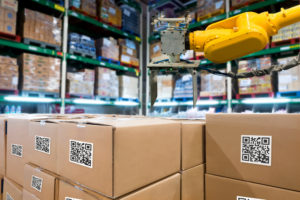4 Ways QR Codes Help Fleet Managers
 As smartphones and other smart devices have integrated themselves into every aspect of our lives, it was only a matter of time before something like the QR code came along, allowing us to scan the code with our devices and view data which interests us. You’ll find QR codes everywhere these days, from advertisements to products, but they’re also helping to run things in more subtle ways too, helping the transportation industry to keep track of valuable cargo and trucks.
As smartphones and other smart devices have integrated themselves into every aspect of our lives, it was only a matter of time before something like the QR code came along, allowing us to scan the code with our devices and view data which interests us. You’ll find QR codes everywhere these days, from advertisements to products, but they’re also helping to run things in more subtle ways too, helping the transportation industry to keep track of valuable cargo and trucks.
In addition to things such as fuel card services, transportation companies are not able to increase their transparency and efficiency by making use of QR codes. So, how exactly are QR codes helping fleet managers to improve their operations and keep track of their shipments more effectively?
1. Commercial Tracking
QR codes were actually initially developed to be used in the automotive industry for tracking orders and maintaining security. Unsurprisingly, they have now become crucial in the trucking and transportation industry, allowing fleet managers to seamlessly track vehicle locations, goods locations, and more. If you’re a fleet manager who’s looking to keep track of where their shipments and drivers are along the supply chain, QR codes are an easy way for members of your team to update you.
QR codes are convenient for this kind of tracking, as they can be preloaded with all the necessary information which is then transmitted upon scanning. This saves time on paperwork, for example, meaning that workers no longer have to manually enter information about delivery statuses – they simply scan a QR code and the stakeholders involved are updated with all the information that they require. By simply using a smart application, fleet managers are able to track their equipment and cargo in real time, and they can even view additional information, such as timestamps and data on who logged certain shipments.
2. Inventory Management Solutions
Old-school inventory management processes were difficult and time-consuming, with workers having to be physically present so as to confirm check ins and check outs as they occurred, noting down the information and passing it along to their superiors. However, with modern QR codes, the QR code stickers/signs are simply put on the relevant trucks and goods, allowing inventory managers to track what’s coming in and out of their inventory much more quickly and accurately than ever before, saving time and reducing human errors.
3. Reducing Cargo Loss/Damage
Of course, companies factor things such as cargo loss and damage into their overheads, along with things such as fuel card services. Nonetheless, this doesn’t mean that losses and damage have to be inevitable! QR codes now help fleet managers and other stakeholders to track the progress of goods along their entire journey, making it much more difficult for them to become lost or damaged on the way. In the old days, managers would’ve had to make several calls and emails in order to constantly track their shipments and reduce losses, but now they can receive all this same information at the mere tap of a button.
4. Improving Security
Although it’s not something which we like to think about, driver theft and fraud are real, and cargo theft does occur from time to time. However, when using a QR code system, the journey of cargo is made much more transparent, and a QR code scanning system will tell fleet managers exactly who has logged the cargo at various points of the journey, making it easier to identify potential thieves along various points of the supply chain. If suspicious losses appear to commonly occur at a certain point in your supply chain, you may be able to use this data in order to confront those responsible.
The GPS tracking capabilities of these systems also make them great for enhancing security too, allowing fleet managers to continuously view exactly where their drivers and goods are on the roads. Also, if there is an emergency, for example, the fleet manager will be able to instantly identify where a driver is, contacting them or sending help to them as necessary.
The Bottom Line
We’re only really scratching the surface of the power of the QR code here, and as with most things, knowledge is power. The more data that a fleet manager has at their disposal, the more effectively they are able to do their job. When combined with fuel card services, which allow you to view insights regarding fuel consumption and financial analytics, fleet managers will have all the information they need to make data-driven decisions with positively affect their fleet’s KPIs and bottom line going forward.
Fuel card services from Fuelz not only save you up to 15% on your fleet’s fuel costs; they also allow you to take advantage of in-depth reports regarding your fuel consumption and expenditure. If you’re interested in signing your fleet up for our fuel card services, get in touch with Fuelz today!
